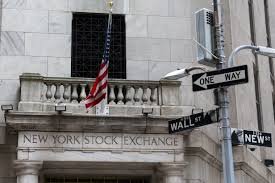Amid escalating trade tensions and financial instability, new tariff-proof market niches are being sought by investors as Wall Street chaos spills into Europe. The global investment landscape has been reshaped dramatically following a wave of U.S. policy shocks and tariff threats, prompting an urgent pivot toward safer, non-traditional assets. As capital flows out of American equities, the search for alternative investment options has intensified.
Tariff-Proof Market Niches Emerge Amid U.S. Policy Shocks and Global Market Reactions
During the month of April, widespread volatility was experienced by Wall Street, sparked primarily by aggressive policy moves from Washington. A significant blow to market confidence was dealt on April 2, following President Donald Trump’s “Liberation Day” announcement, which intensified concerns around trade protectionism. As a result, sharp declines were witnessed in major U.S. stock indices, including the S&P 500 (.SPX), while the dollar also came under pressure.
The abrupt shift in sentiment led to a swift redirection of capital. Initially, European equities had been targeted as a relatively stable haven by fleeing investors. However, that strategy was soon disrupted by a rapid appreciation of the euro, which reignited fears of weakened export competitiveness across the eurozone.
European Markets Struggle Amid Euro Surge
The investment momentum that had been gained by European markets proved to be short-lived. The euro’s surge, driven by safe-haven demand and unfavorable dollar movements, has weighed heavily on European stocks, particularly exporters. Companies dependent on trade have been affected adversely, leading to decreased investor appetite for European equity exposure.
At the same time, bond yields in the region have remained volatile, and political uncertainties in several EU member states have added further complexity to market decision-making. In this environment, traditional market strategies have been rendered ineffective, prompting a significant realignment of investor focus.
New Safe Havens Identified by Global Investors
In response to these unfolding events, investment flows have begun to move toward niche markets considered resistant to trade policy shocks. Among the most favored areas have been Latin American currencies and precious metals stocks, particularly in the gold mining sector.
Latin American economies, which had been perceived as vulnerable in previous global downturns, are now being reevaluated. Currencies such as the Brazilian real and Mexican peso have seen renewed interest, as their relative independence from U.S.-Europe trade dynamics has been viewed as an asset. In addition, emerging market bonds and equities in these regions have shown resilience, drawing in global capital.
Gold mining stocks have also been thrust into the spotlight. In times of policy instability, precious metals are typically turned to by investors as a store of value. With inflation fears on the rise and fiat currencies facing downward pressure, gold-related assets have been embraced as a dependable hedge. Mining companies, in particular, are being favored due to their potential for strong returns amid elevated metal prices.
Technology and ESG Sectors Offer Tariff Immunity
Apart from traditional safe havens, sectors with built-in tariff immunity have begun to attract attention. Technology firms focused on domestic innovation and digital services have been considered less exposed to trade disruptions. Companies involved in artificial intelligence, cybersecurity, and cloud computing have shown stability, even as global markets fluctuate.
Moreover, Environmental, Social, and Governance (ESG)-driven investment options have maintained their momentum, with many funds shifting toward sustainability-focused portfolios. These assets, by virtue of their diversified holdings and forward-looking strategies, have been perceived as better insulated from trade-related volatility.
Institutional Investors Rethink Global Allocation Strategies
In response to recent turmoil, major institutional investors have begun to reevaluate their global asset allocation models. Traditional frameworks based on regional diversification are being replaced by thematic and risk-adjusted approaches. Asset classes are being judged not just by geography, but by their resilience to macroeconomic shocks and policy unpredictability.
Portfolio managers have increasingly turned to data-driven modeling to identify under-the-radar investment opportunities. Predictive analytics and AI-based risk assessment tools are being used to forecast the impact of tariffs, sanctions, and policy announcements. This shift in strategy has allowed for more agile responses to global uncertainties.
The Outlook for Global Markets Remains Cautious
While new opportunities have been identified, the broader outlook for global markets remains cautious. The effects of U.S. trade policy continue to ripple across continents, and confidence in traditional markets has been shaken. Volatility is expected to remain elevated in the near term.
Policymakers have been urged to provide clearer guidance on trade intentions, as uncertainty has been one of the main drivers of market dislocation. Until such clarity is provided, investors are likely to continue their flight toward less conventional assets, relying on diversification and niche sector strategies to protect returns.
Conclusion
The ongoing trade-driven market turmoil has prompted a significant transformation in global investment strategies. As Wall Street chaos hits Europe, investors are seeking new tariff-proof market niches to safeguard their capital. From Latin American currencies to gold mining stocks and tech-driven ESG portfolios, a wide array of alternative options are being explored. With traditional safe havens under pressure, adaptability and innovation have become essential traits for navigating the modern financial landscape.


